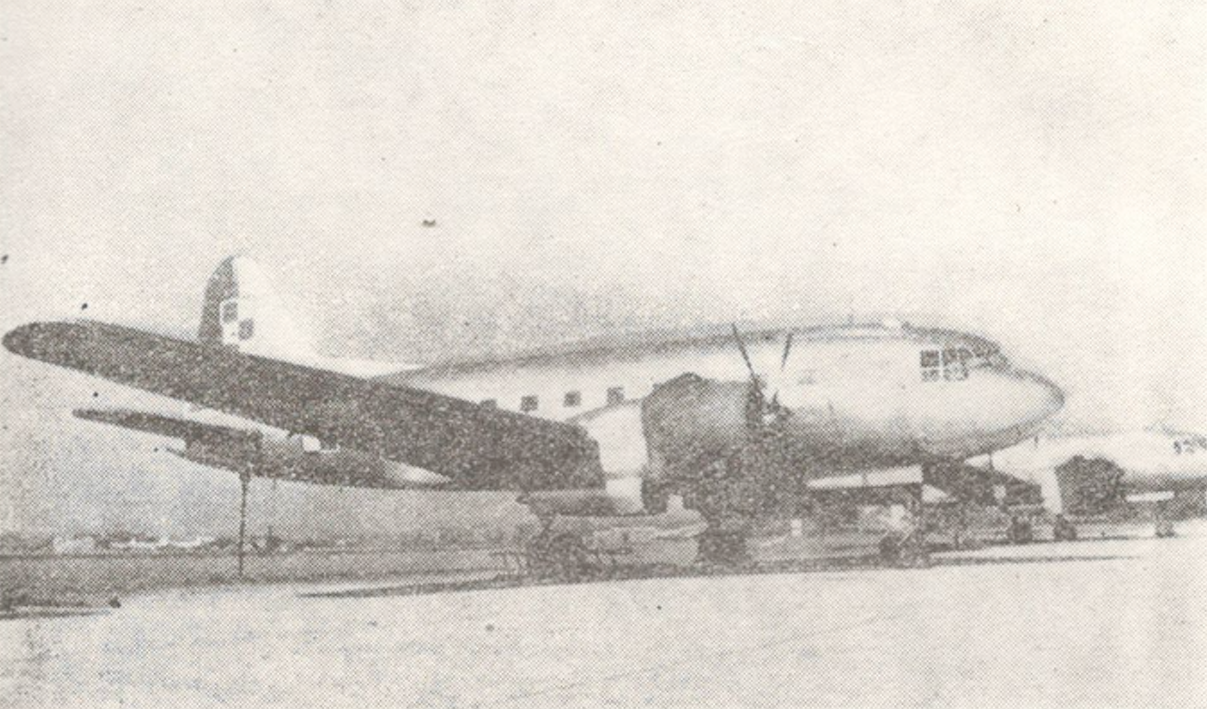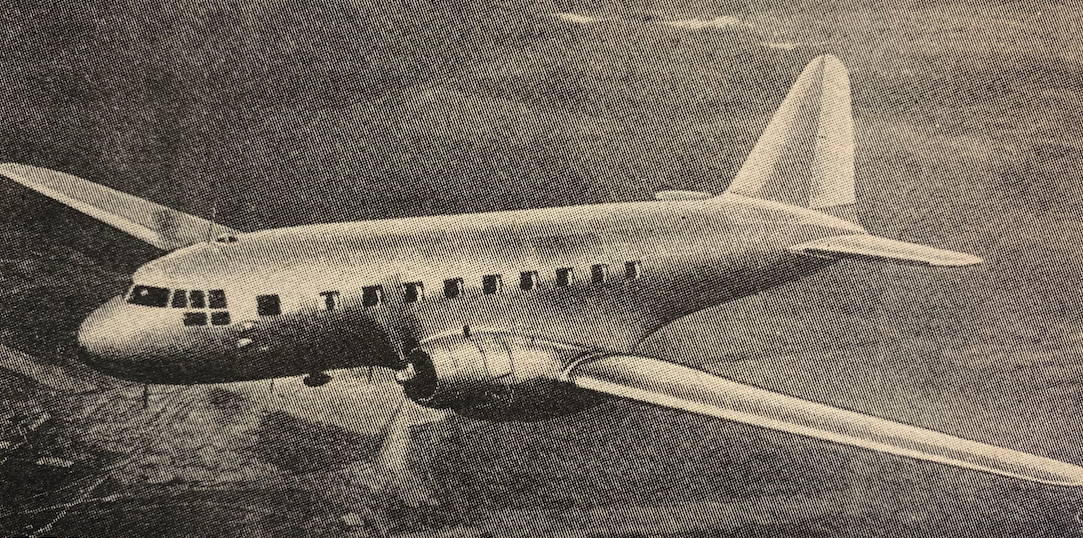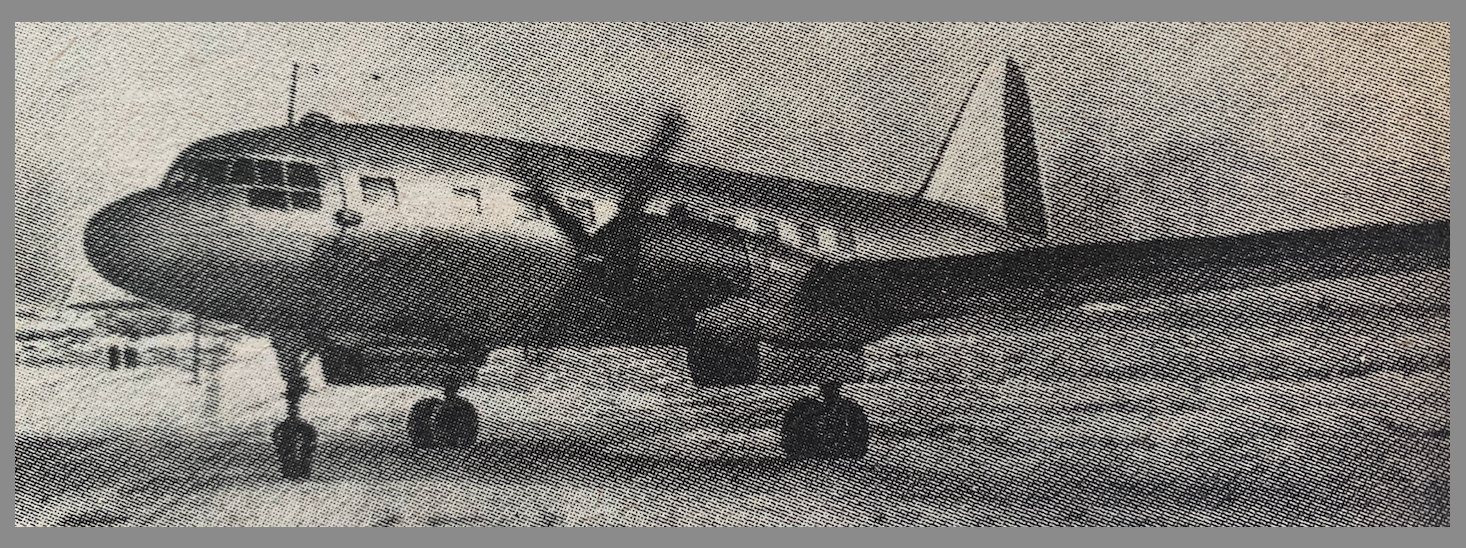Kraków 2008-10-16
Iliuszyn Ił-12.
075b Tally 1949-09-04
The Iliushin Il-12 is a Soviet transport aircraft developed in the OKB Ilyushin office. The aircraft was the successor to the Lisunow Li-2 aircraft. The aircraft was modeled on the designs of American aircraft.
Photo description: One of the few photos of Il-12 military aircraft in Poland. The Il-12 aircraft are easily distinguished from the Il-14 by the shape of the vertical tail.
The history of the Il-12A aircraft.
Even during the hostilities (World War II), a team of designers led by Sergei Vladimirovich Ilyushin started to develop a new Li-2 class transport aircraft. Naturally, it had to be a more modern design. Attention was paid to the improvement of flight safety and the possibility of operation in various climatic conditions in the CCCP area. Even the temperature; minimum -67 degrees C in Yakutsk, maximum +60 degrees C in Tashkent. The basic change in the Il-12, compared to the Li-2, was the introduction of a three-support chassis with a front wheel. This layout causes the plane to taxi in a horizontal position, which greatly improves visibility from the cockpit during maneuvers at the airport.
A new four-blade propeller was used. The propeller is adjustable, so you can change the angle of attack. This change can lead to feathering of the propellers. This has the advantage that when one of the engines fails, its propeller does not offer much resistance. On one running engine, not only horizontal flight is possible, but also a small climb up to 1,000 m above sea level.
Work on the aircraft began in the autumn of 1943, but continued with interruptions due to more pressing other work and the ongoing war. There was even a possibility of completely stopping work on the aircraft. Stalin agreed to continue the work, provided that the aircraft was also adapted to the needs of the army. The aircraft, in addition to carrying passengers and goods, was to be able to perform a parachute landing and tow transport gliders. Since most of the tasks were to be performed at a low ceiling, and also due to the small budget, the airtight crew and passenger cabins were abandoned.
The first prototype flew on August 15, 1945. However, it turned out that the ACz-31 engines used were extremely emergency. In order to save the situation, it was decided to use the ASz-82 engines, not very modern, but proven in many combat aircraft designs.
In December 1945, a prototype with ASz-82 engines was completed, intended for flight tests. On January 9, 1946, the prototype made its first flight. They were at the controls; Vladimir K. Kokkinaki (famous aviation record holder) and his brother Konstanty K. Kokkinaki. After the completion of factory tests, the aircraft successfully passed state tests and received permission to enter into operation at Aeroflot. At that time, it was given the designation Il-12. Also in 1946, serial production began in Moscow, in one of the oldest aviation factories "Znamia Truda", where, among others, Il-2 and Il-10 attack aircraft were built.
On May 1, 1947, the aircraft in the number of several copies was demonstrated in flight during the parade in Moscow. The aircraft was not refined and required many modifications during its initial operation. As a result, the anti-icing system of the wings, empennage, crew cabin windows and propeller blades was built. The leading edges of the wings are de-iced by hot air heated in an oil cooler. The leading edges of the tail are also de-iced with hot air. This air is taken from grips on both sides of the fuselage near the horizontal tail, heated by electric heaters and directed to the leading edges. The front windows in the crew cabin, so as not to freeze, received a spirit spray installation. Propeller blades are also de-iced with spirit distributed in small doses through grooves located along the leading edge of the blades. That is, de-icing consists in washing the propeller blades, as well as the crew cabin windows.
The aircraft received effective heating of the cockpit and passenger cabin. At an outside temperature of -50 degrees C, a constant temperature of up to +25 degrees C can be maintained in the cabin.
Il-12B version.
In 1949, serial production of the modernized version of the Il-12 B began, which, in addition to the changes listed above, received a number of others. This version has an inflow (dorsal fin) before the vertical tail. The engine covers were changed as the aircraft received modernized engines. The exhaust pipes are also different. To improve the safety of the structure, the total weight was reduced from 17,250 kg to 16,100 kg. This was mainly achieved by limiting the fuel supply.
The Il-12 B version entered the equipment of Aeroflot and the Aviaarktika company, which used these aircraft to communicate with scientific bases in the Arctic and Antarctica.
The Ił-12 B version entered the equipment of LOT Polish Airlines and Czechoslovak CSA. A little later, the plane was adopted by Romania, Bulgaria and China. Despite many shortcomings, the plane was correct in handling, easy during take-off and landing. Thanks to the high power of the drive unit, it was possible to safely use it at high-altitude airports, both with concrete (asphalt) and ground (grass) surfaces. The full-load run on grass is less than 500m and the rundown is 700m. However, it was the powertrain that caused the most problems. Failures occurred quite often, and fuel consumption was too high compared to newer designs.
For the army, the production of the airborne version and the transport of loads weighing up to 3,000 kg and the towing of transport gliders such as; Yak-14, KC-20. The aircraft of this version received a large loading door on the left side of the fuselage, opened on the ground. On the top of the hull there is a movable turret for the gunner servicing the SZKAS or UBT machine guns. On the left side of the fuselage, just behind the cockpit, there is a protruding transparent dome. A sight was placed there for landing landings. The plane takes on board 37 parachutists or 26 fully equipped soldiers, or 16 wounded on stretchers, plus 6 in a sitting position.
A typical transport version was also created, marked Il-12 T. It had only a cargo hold (without any seats), which holds 3,500 kg, and often 4,000 kg of cargo was taken in normal operation.
In general, the Il-12 turned out to be a construction with numerous shortcomings. Only its successor, the Il-14, became a mature structure and operated for many years, also in Poland. Production of the Il-12 lasted from 1946 to 1950, and ended with about 3,000 machines of all versions, for the army and civil aviation, for the CCCP and for export.
On October 24, 1958, the Il-12 was the first Soviet plane to fly over the South Pole.
Il-12 for Poland.
The Il-12 aircraft was offered for export through the Foreign Trade Center Aviaxport. The headquarters showed this aircraft and the Jak-16 and Jak-18, in Poznań at the Ławica airport, on April 24, 1948 – May 9, 1948. as part of the 21st MTP (Poznań International Fair). The Il-12 was marked CCCP-L1701 and belonged to an early production series. Explanations and answers to journalists’ questions were provided by the pilot Konstanty K. Kokkinaki himself, who also presented the plane in flight with passengers on board.
Il-12 at LOT Polish Airlines.
In 1949, LOT Polish Airlines purchased 5 Il-12 B passenger planes, which received registration marks; SP-LHA, SP-LHB, SP-LHC, SP-LHD, SP-LHE. The new aircraft was publicly demonstrated for the first time at Okęcie on September 4, 1949, on the occasion of the Aviation Day. The aircraft was also shown in the air, demonstrating flight with climbing on one working engine, with the other turned off, whose blades were set in a flag.
Ił-12 B aircraft at LOT Polish Airlines had 18 or 21 passenger seats. Their number during operation was increased to 28 pieces. In 1952, for a few months, another Il-12 B was rented, which received the registration SP-LHF. At PLL LOT, the planes were used until the end of 1957, and the last three machines, with registrations SP-LHA, SP-LHB, SP-LHC, were left in reserve and preserved until November 1959.
Il-12 for the Polish Army.
In 1950, two planes were purchased, one Il-12 B nb 002 intended to carry important personalities, possibly cargo, and one Il-12 D nb 001.
On November 6, 1959, the military took over (rented) three Il-12 B aircraft (presumably SP-LHA, SP-LHB, SP-LHC) from LOT Polish Airlines, adapting them for transport and parachute landing. The last copies were canceled in the 60’s. The Il-12 D nb 001 aircraft ended flights in 1966, while the Il-12 B nb 002 in 1969.
Il-12 versions.
Il-12 A – first serial version. It takes 27 passengers.
Il-12 B – passenger version developed in 1949, externally received an influx (aerosteering wheel) before the vertical tail. Asz-82 FN-212 engines with 2 x 1,630 hp. The plane takes 27 passengers, and on shorter routes even 32 passengers. A saloon for 11 passengers was created, with a range of 4,000 km and a sanitary version.
Il-12 D – version for the army built in 1948-1949, the plane takes 37 jumpers or 26 soldiers. It can tow 1 or 2 transport gliders.
Il-12 T – is a typical cargo version. It has a reinforced floor and a deck crane with a lifting capacity of 1,500 kg. Built in 1949.
Il-12 design.
Transport or passenger aircraft for 21 – 28 passengers. Nominal capacity 3,500 kg. For the parachute landing, he takes on board 37 parachutists. It can take 26 soldiers with full equipment on board. The flight crew consists of 4 aviators; 2 pilots, navigator and radio operator.
The Il-12 is a twin-engined, all-metal low-wing monoplane.
The three-girder wing is technologically divided into three parts. Working roof reinforced with stringers. The middle wing (centre wing) is permanently attached to the fuselage. It houses the engine nacelles with the engines and main landing gear. The leading edges of the wing are de-iced with hot air. An oil cooler is located under the engines. The air is heated there and directed into the ducts closed in the wing tips, warming them and escapes through openings near the engine nacelles.
Classic frame and stringer hull with working skin. It consists of three parts; the front one with the crew cabin, the middle one with the passenger and cargo cabin, the rear one to which the tail is attached. The hull cross-section is circular. In the transport version, the cargo cabin has a reinforced floor. The classic aircraft door was placed in the rear of the fuselage on the starboard side. Paratroopers are also deployed through this door. On the opposite side, on the left side, there is a two-piece larger loading door that opens only on the ground. The cockpit and cargo cabin are not airtight, but heated with warm air. In the rear part there is a small additional cargo compartment, which can be accessed from the cargo cabin or through a small door on the left side of the fuselage.
Classic, free-supporting tail. Metal construction. The fins are covered with sheet metal, but the rudders are covered with fabric. Horizontal tail with a strong rise of +6 degrees. Leading edges heated with hot air. This air is drawn through grips in the rear of the fuselage, heated by electric heaters and directed to the noses of the tail.
Three-support chassis with front wheel. Front with a single wheel, retractable to the fuselage to the rear. The main ones with doubled wheels, hidden forward into chambers located in the engine nacelles. Oil-air shock absorbers. The landing gear is complemented by a small wheel, partially protruding, acting as a bumper at the end of the lower part of the fuselage during take-off and landing. When stationary, the rear of the fuselage is supported by a rack that prevents the aircraft from tilting on its tail when loading and unloading cargo.
Il-12 drive.
Two ASz-82 FN-212 engines, 14-cylinder in a double star system, carburetorless, with direct fuel injection and a two-stage compressor. Take-off power 2 x 1,362 kW (2 x 1,850 HP), and nominal power 2 x 1,200 kW (2 x 1,630 HP). NACA engine covers with adjustable air intake. Exhaust pipes discharge exhaust gases at the end of the engine nacelles. Four-bladed AW-9 propellers with a diameter of 4.1 m, adjustable even to a flag. The blades are de-iced with spirit dosed cyclically and flowing down the grooves on the leading edge of the blades.
Fuel tanks placed in the wings in the amount of 6 pieces, with a total capacity of 4,150 liters. Oil tanks with a capacity of 2 x 220 liters, each placed in the engine nacelle.
Avionics equipment.
RSB-7 and RSB-5 on-board radios, ARK-5 automatic radio compass, RPKO-10M radio semi-compass, AP-42A automatic pilot.
Armament.
The design of the Il-12 D provided for the possibility of mounting a defensive turret on the top of the hull, armored and equipped with 1 machine gun. SZKAS or UBT operated by the gunner. Airplanes used in Poland did not have such a turret. However, in the windows of the transport compartment there are sight-holes that open from the inside and allow firing from small, automatic or machine guns.
T-T data of the Il-12 aircraft.
Span 31.70 m, length 21.31 m, height 7.81 m, bearing surface 103 m2, curb weight 11,000 kg, gross weight 17,250 kg, load weight 3,500 kg, fuel 4,150 liters, maximum speed 407 km /h, cruising speed 320-366 km/h, landing speed 128 km/h, range 3,230 km, range with a full load 1,500 km, ceiling 6,500 km (the crew uses oxygen masks), take-off 475 m, take-off 563 m.
List of Il-12 aircraft in Poland.
1 Ił-12 B registration SP-LHA. Purchased for LOT in 1949. Operated until 1957. Preserved. On November 6, 1959 the aircraft was taken over by the army. Exploited up to 1963.
2 Il-12B registration SP-LHB. Purchased for LOT in 1949. Operated until 1957. Preserved. On November 6, 1959 the aircraft was taken over by the army. Exploited up to 1963.
3 Il-12B registration SP-LHC. Purchased for LOT in 1949. Operated until 1957. Preserved. On November 6, 1959 the aircraft was taken over by the army. Exploited up to 1963.
4 Ił-12B registration SP-LHD. Purchased for LOT in 1949. Operated until 1957.
5 Il-12B registration SP-LHE. Purchased for LOT in 1949. Operated until 1957.
6 Il-12B registration SP-LHF. Aircraft rented in 1952. by LOT for several months.
7 Il-12 D nb 001 purchased for the Army in 1950. in 1966 end of operation.
8 Ił-12 B nb 002 purchased for the Army in 1950. in 1969 end of operation.
Written by Karol Placha Hetman



